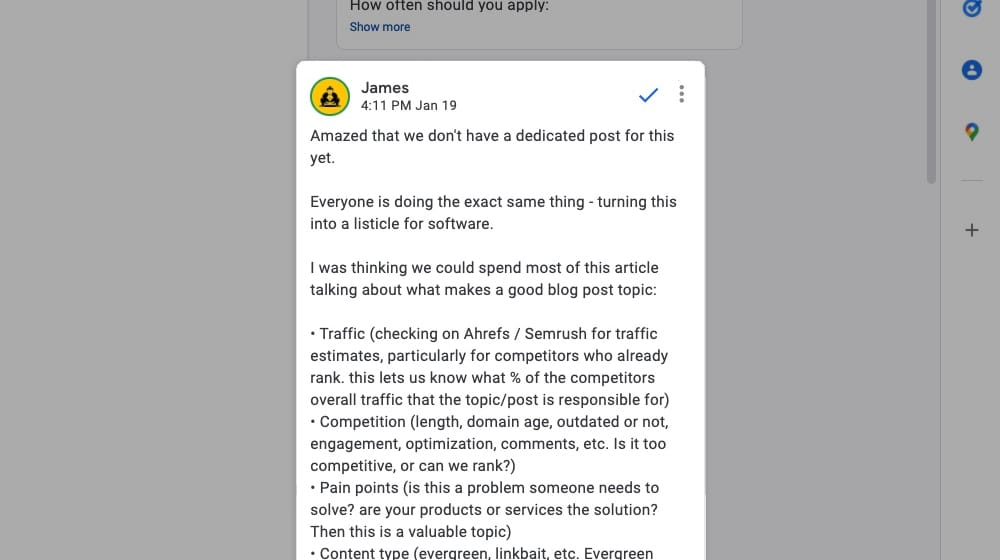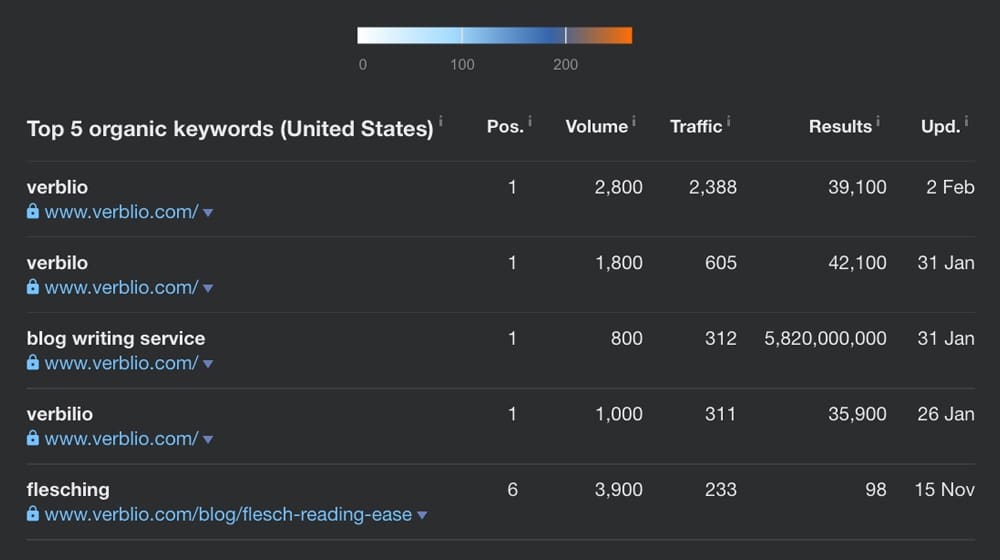Tutorial: How to Create an Excellent Content Brief for Writers

Some marketers and business owners write their content themselves. They perform research, develop ideas, and write their expertise on the page.
Sometimes it's a public deal, like how many businesses hire professionals to write content for their blog. Others – many, many others – hire writers to do so for them. Most of the time, though, it's a ghostwriting arrangement.
In ghostwriting, your writer handles the content creation for you, but you own the content they produce, its rights, and the ability to put your name on it. Ghostwriters are okay with this arrangement because they get paid for it, and you save time and energy in exchange for money, so it all works out.
The trick is getting your writer to write what you want them to.
Now, once you've worked with a writer for long enough, you build up a rapport and a common language. They know how you think and what you want; you know how they write and where their boundaries and expertise are. You work together.
For a newer writer, or for a writer you only work with sporadically, or for a writer who handles many clients and isn't just working with you, you might need a little assistance to ensure that you get the best results out of your content creators.
That's where a content brief comes in.
What is a Content Brief?
In short:
The brief immediately follows the topic ideation process. Once you've decided on a good topic that you'd like to write about, detailed content briefs will help arm the writer with everything they need to create a top-notch content piece.
For more information on the topic selection process, you can check out these detailed guides that I created on the subject here:
This post will focus on the information you'll provide to writers, so I won't include responsibilities that are too outside of the scope of writing. For example, the search volume and organic traffic estimates, SERPs, images and visuals, social media posting; these things are best suited for your marketing team, editors, and graphic designers.
In some cases, the brief is, well, brief. It's often just a few sentences long and describes the type of content and focus in simple terms. These kinds of briefs are best for experienced writers and writers you've worked with for a long time.

In other cases, the brief is a standardized document and template that can run a page or longer, including everything the writer needs to go from "never worked with this company before" to "producing high-quality content within brand guidelines."
Now, I want to clarify something before we go too much further.
You might get perfect content out of it, but that's more on the skill and experience of the content writer than it is on the brief. What is the purpose of the brief, and how does it fit into a content marketing strategy?
In my mind, there are three.
1. The brief guides the writer's coverage of a topic.
This part is the most flexible portion of the brief. It's the information you (or your content strategist) give to your writer to ensure they're on the right page, performing keyword research to uncover the best topics, and writing in the right way about the right spin.
A brief gives them a rough direction. For example, some writer notes for a "ten critical SEO tips for 2022" post might include 8, 9, or even all 10 of the tips you want. If you don't specify the suggestions, your writer has to come up with them, and they might not cover what you want. So, providing the information you wish to include ensures that it's included.

If you have a group of ten writers create an article on the same topic, you'll probably get different tips in every piece. A brief helps keep writers focused on the points you want to drive home and bring it closer to what you had in mind.
Pretty simple, right?
2. The brief serves to minimize revisions and edits.
As mentioned, the brief is not meant to result in perfect content, just good content. Your editor, overview, and workflow are designed to take that first draft and turn it into ideal brand content.
Different companies function differently here. I prefer to train my writers to get things as close to "perfect" as possible (the first time) and then take it the rest of the way myself. I rarely request revisions, only when the writer has gone off-target or written out a tangent.
Other companies might have their core writer produce anything and then send it back for two or three rounds of revision to make it perfect. I've even seen companies that do this to make meaningless changes, to "get the most out of their writers." Believe me; writers hate this. But, sometimes, the writer has no choice but to accept.

Editing is always recommended to polish your posts into the best content possible. Only some of the most professional writers out there will be able to create "perfect" articles in a single pass, and even then, you might need to work with them to nail things like brand voice and consistency. The writer rarely will produce publication-ready content right out the gate in either case.
Incidentally, that's why many of the top freelancers out there insist on writing under their name; that way, inconsistencies in the tone of voice can be attributed to their voice and not to mistakes.
3. The brief ensures a consistent voice across multiple writers.
Many companies end up working with more than one writer. There are many reasons for this:
- They work through a content mill and play the lotto every time they post a new assignment.
- They have a roster of part-time writers, none of whom can fill the blog consistently on their own.
- They endeavor to produce more content than one writer can feasibly handle regularly.
If all of that content is published under the blog owner's name or a specific writer, then it can stand out to long-time readers if the content isn't consistent. Differences in tone, voice, perspective and even opinion can stand out. So, the brief is meant to help enforce guidelines that bring all of the content to heel.
What Should a Content Brief Include?
What I've come up with here is a process that you can adapt into your own content creation process. I've seen a lot of different variations and even created variations myself. I don't provide even a fifth of this with my most talented writers because I don't need to. I might offer more with a new writer or a writer I'm not as familiar or comfortable with. Some companies have large content brief templates they fill out for every post (and the writer can ignore most of it as redundant information each time) to make it easier to be consistent across writers.
All of that is to say that, while I've listed what an effective content brief can include, it doesn't have to include everything below. Pick and choose what you and your writer need to work together and produce top-tier content.
1. The general topic and specific H1 title.
I like formulating the H1 title from the get-go. My shortest briefs are just descriptive titles, which is the essential part of the brief. At the bare minimum, you want the core topic, so your writer knows the general direction of what they'll be writing about.

You can't just say "something about SEO"; you need to say "30 Tips to Improve The SEO of Your Dropdown Menus" or what have you. Hence, the writers know what the post's focus is beyond just a keyword since (as I mentioned so often elsewhere) one keyword can produce multiple pieces of content with different priorities quickly.
2. The target keywords.
Keywords are an essential part of SEO, though perhaps less so than they used to be. Keyword density isn't because Google does a lot of semantic indexing and natural language processing to equalize it. Still, at the very least, you may want the writer to include the primary keyword and secondary keywords in your post. Of course, your keyword should show up in the H1 title as well, so a clever and experienced writer will be able to suss it out on their own, but it helps to be explicit.

Some teams may decide to skip this step to unburden their writers and optimize their keywords during an editing pass. The decision is up to you.
3. Technical requirements, like length, links to add, and deadlines.
Sometimes this is critical information; sometimes, it isn't. For example, I work on a consistent week-to-week basis, so my deadlines are always the same. I also have standardized lengths, so all my writers know their target word count for every post. I don't need to include those in a brief since they're part of orientation when I hire a writer in the first place.

Sometimes specific links, the particular product being promoted, or a particular tip or topic to cover, can be included. Anything unique to the post (rather than consistent in all articles for a given client) is added to the brief.
4. The target audience, buyer persona, and search intent.
These phrases are all the semi-advanced content marketing stuff that can make a big difference in how content is produced. However, it's also details that a novice writer might not know how to capitalize on, and an experienced writer might handle intuitively.

Still, it can be worthwhile specifying things like:
- Is the content B2B or B2C?
- Is the target an entrepreneur, a small business, a large company, an individual?
- Is the post's goal to inform, provide a tutorial or guide, or encourage purchase?
These kinds of details guide how the post turns out. Most of it is inherent enough to the article that it needs to be written in from the ground up. Some can be changed in post, pushed in one direction or another.
5. Any required information that should be included in the post.
This step is an obvious one. If you have a post title like "10 Essential SEO Tips for 2022" and want five specific tips included, include those tips in your brief. You can leave the other five up to the writer or come up with another five to fill in, whatever you want. Anything that has to be in the finished product should be specified in your brief.
6. Any information or language that you should avoid.
Conversely, you also want to include anything that shouldn't be in your brief.

To use a real-life example from one of my clients, I work with a pet-focused blog that wants to avoid the phrase "pet owner" and prefers "pet parent." That's fine, it's an easy substitution, and it guides the choice of language used in the posts. Into the brief, it goes.
7. An outline.
Sometimes, a topic is complex enough, or your idea specific enough, or a writer inexperienced enough, that you want to provide more guidance. Sometimes, you want to have total control over your content.

In these cases, writing a complete outline for the post is the way to go. It's more work for you to create the brief, but it helps ensure that your vision for the content is accurate to what is eventually produced.
8. Links to style guides, brand voice documents, etc.
These guidelines are bits of information that you give to the writer to reference in general because it's consistent across every post. Including it in every brief makes the brief longer and harder to parse.

I don't consider a writing style guide, a house style, a brand voice, or any of those kinds of general guidelines to be something that needs to be in your brief itself.
Considerations for Writing a Content Brief Appropriately
One thing to consider is how complex a content brief is, weighed against your chosen writer's skill level and experience level.
If I were to submit a content brief to a content mill like Textbroker, I would make the brief as long and detailed as possible. There are a lot of freelance writers on that platform who have minimal idea of what they're doing, and I want to make sure I get something that ends up in at least the right ballpark of what I want.
On the other hand, if I'm working with a writer that I've known for years and who consistently produces content precisely where I want it (or within the same area, plus or minus 10%), my brief might be short or nonexistent. I have a few of those on my roster, and you probably wouldn't be able to tell the difference between a piece of content I write personally and one I have them create for me.
It can pay to recognize that a very complicated and detailed brief can be detrimental to your writing. Some of the best writers out there know what they're doing and how to produce content that ranks well and converts, and if you're giving them detailed instructions in a brief, it's like asking someone to build you a house while handcuffed. Plus, it can indicate that you're going to be very picky and detail-oriented (possibly while ignoring the big picture), which can be frustrating to work with.
If you find the writer needs more guidance, provide that guidance. If you find they don't, and the post still comes out better than you expected, perhaps you don't have to enforce these briefs as rigidly. It's an evolving relationship (if you do it right), so adjusting how much detail you put into your briefs should be expected.
Moreover, writers have different specialties. I have writers who are experts for specific clients and novices for others; the same writer might get a two-sentence brief for one client but a half-page one for another, just because I know they know a lot more about one subject than another. Some posts require optimization, and others are already search engine optimized with meta descriptions, internal links, external links, subheadings, and more. It's all contextual.
The long and short of it is that the content brief is a personalized document created to reflect your relationship with your content team. You should adjust it accordingly, giving your writer the freedom to evolve the article into what it needs to be.










April 27, 2022
We're going to start working with a freelance writer so this tutorial is very useful
April 29, 2022
Thanks Lisa! Congrats on your new writer.